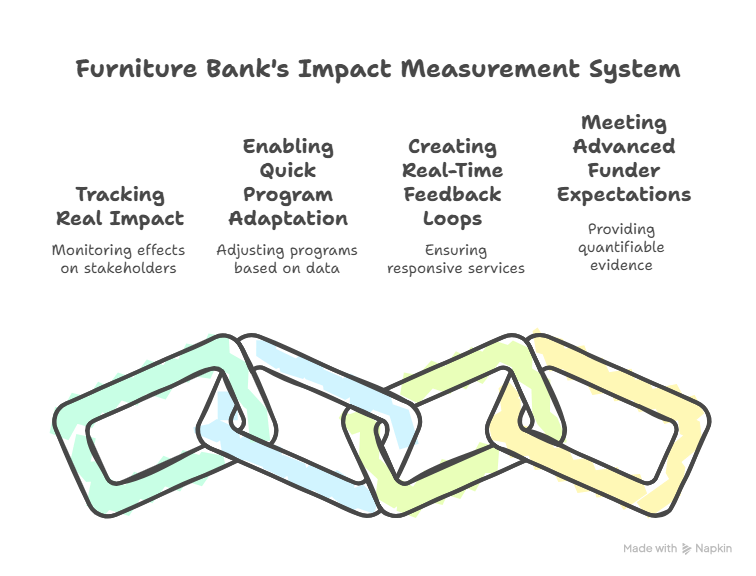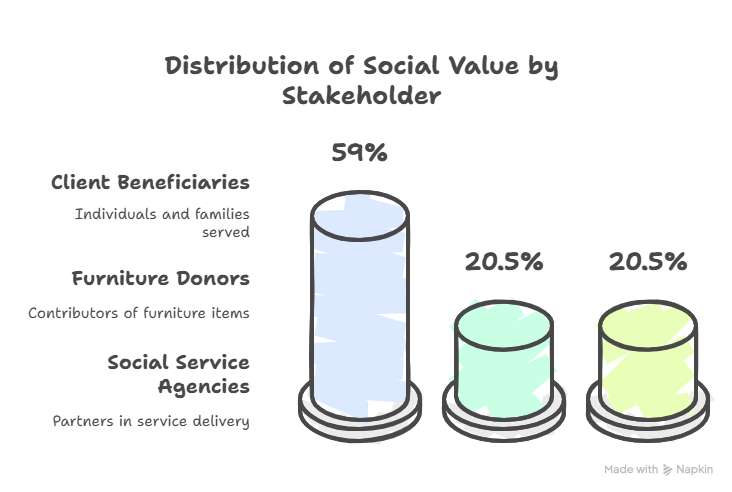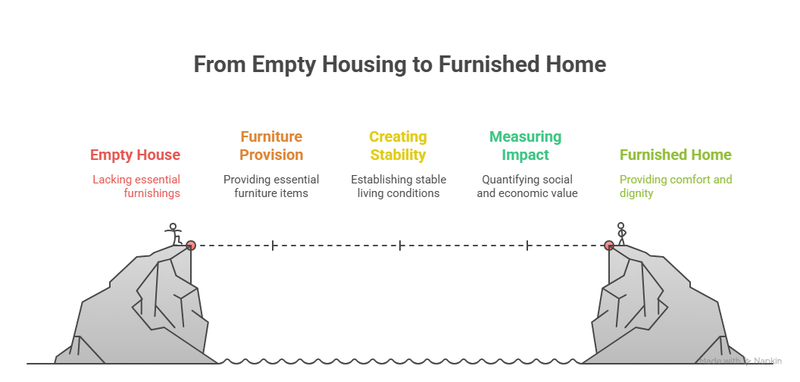Understanding Furniture Poverty: The Hidden Housing Crisis
The Scope and Impact of Furniture Insecurity
Furniture poverty extends far beyond mere inconvenience. Living without essential furnishings impacts physical health (inadequate sleep from lack of proper beds), mental wellbeing (stress, anxiety, and shame), and social integration (inability to host visitors or create normalcy for children).
For families transitioning from homelessness, the cost of furnishing even a basic two-bedroom apartment can exceed $5,000 – an insurmountable barrier when already struggling with rent, utilities, and basic necessities. This expense typically consumes 20-25% of a housing budget, forcing impossible choices between furniture and other essentials.
Consider the experience of the Rodriguez family, who secured subsidized housing after eight months in a shelter. While grateful for walls and a roof, they spent their first three weeks sleeping on the floor, using plastic bins as makeshift tables, and feeling as though they hadn’t truly escaped homelessness despite having an address.
Beyond Traditional Charity Metrics
Conventional approaches to measuring charitable impact often fall short when addressing furniture poverty. Tracking the number of sofas or beds distributed provides an incomplete picture of transformation.
“Traditional metrics tell us what we did, not what changed as a result,” notes Kershaw. “We needed a framework that captured not just the items provided, but how those items created stability, dignity, and opportunity.”
This recognition led Furniture Bank to develop a measurement approach that quantifies outcomes across multiple dimensions – from immediate comfort to long-term housing stability, from individual wellbeing to community integration, and from waste diversion to carbon emission reduction.
Furniture Bank’s Comprehensive Impact Measurement Framework
Four Core Measurement Capabilities
Furniture Bank’s impact measurement system provides four critical capabilities that drive both accountability and continuous improvement:
- Tracking real impact for all stakeholders affected by our work, including clients, social service agencies, furniture donors, staff, volunteers, and the environment.
- Enabling quick program adaptation with confidence, based on data rather than just stories. This allows for faster creation and adjustment of programs compared to relying solely on anecdotal evidence.
- Creating real-time feedback loops to guide continuous improvement, ensuring services remain responsive to changing needs and circumstances.
- Meeting advanced funder expectations for rigorous impact documentation beyond photos and stories, providing quantifiable evidence of social return on investment.


Evolution of Measurement Approach
The journey toward this comprehensive framework began in 2022 with a thorough audit of existing impact measurement activities. This assessment revealed both strengths and gaps, leading to the development of an improvement roadmap that has guided implementation since 2024.
The roadmap included several key processes:
- Stakeholder mapping to identify all groups affected by Furniture Bank’s work
- Pillar identification to organize activities into coherent impact areas
- SDG mapping to align with global sustainability frameworks
- Theory of Change development to articulate how activities lead to outcomes
- Program-level impact measurement to track specific interventions
- Development of a comprehensive impact measurement framework
This methodical approach has transformed how Furniture Bank understands, measures, communicates, and enhances its impact across multiple dimensions.


The Four Pillars of Impact
Furniture Bank organizes its activities and impact measurement around four key pillars, each with specific pathways toward ultimate impact:
Pillar 1: Homing


Definition: Transforming empty housing into nurturing, personalized environments through the intentional addition of furniture, personal items, and community support.
Ultimate Impact: Helping individuals and families experiencing furniture poverty achieve sustainable livelihoods and become active community members.
Furniture Bank supports people in transitional housing, social housing, and affordable rental housing by providing essential furnishings that create stability and belonging. The organization aims to have the term “homing” recognized in the dictionary as the act of creating a sense of belonging through furnishing.
Case Study: When Amina and her three children moved into their apartment after fleeing domestic violence, they had nothing but suitcases of clothing. Through Furniture Bank, they received beds, a dining table, a sofa, chairs, lamps, and kitchen essentials. Three months later, Amina reported that her children’s school attendance had improved, she had secured employment, and for the first time in years, they had invited friends over for dinner – a simple act that represented profound normalization and dignity.
Pillar 2: Social Employment


Definition: Providing employment opportunities to individuals facing barriers through the Leg Up program.
Ultimate Impact: Assisting individuals in breaking barriers to employment, achieving sustainable livelihoods, and becoming active community members.
The Social Employment pillar addresses both furniture poverty and employment barriers simultaneously, creating pathways to economic independence through skills development in furniture restoration, logistics, customer service, and warehouse management.
In 2024, the Leg Up program achieved an 83% job placement rate, with participants reporting significant improvements in financial stability, self-confidence, and professional skills. Many graduates have secured positions within the furniture industry, creating a virtuous cycle of impact.
Pillar 3: Sustainable Consumption

 Definition: Encouraging individuals and corporations to recycle furniture and household items, diverting waste from landfills and reducing environmental impact.
Definition: Encouraging individuals and corporations to recycle furniture and household items, diverting waste from landfills and reducing environmental impact.
Ultimate Impact: Creating a circular economy for furniture that minimizes waste and environmental harm while maximizing resource utilization.
In 2024 alone, Furniture Bank diverted 953 tonnes of furniture from landfills, preventing over 4,000 tonnes of carbon emissions. This environmental impact extends beyond waste reduction to include the carbon footprint avoided by reusing existing furniture rather than manufacturing new items.
Corporate partnerships have been instrumental in this pillar, with companies like IKEA participating in take-back programs that ensure furniture remains in use as long as possible before recycling.
Pillar 4: Network Development


Definition: Providing support services to other reuse charities and collectively increasing capacity across Canada.
Ultimate Impact: Empowering all furniture banks in Canada to increase access to furniture, minimize furniture waste, and create a more equitable furniture distribution system.
Through the Furniture Bank Support Services (FBSS) platform, the organization collaborates with like-minded charities across Canada to address furniture poverty as a national issue. In 2023, this network supported 7,423 individuals across Canada, demonstrating the scalability of the model.
The Network Development pillar focuses on standardizing impact measurement approaches across furniture banks, creating collective data that strengthens advocacy efforts and improves service delivery nationwide.
Alignment with Sustainable Development Goals
Furniture Bank has mapped its pillars and key activities to the UN Sustainable Development Goals (SDGs) at the target and indicator level, directly contributing to:
- SDG 1: No Poverty – By addressing material poverty and creating pathways to sustainable livelihoods
- SDG 8: Decent Work and Economic Growth – Through the Social Employment pillar and Leg Up program
- SDG 11: Sustainable Cities and Communities – By supporting housing stability and community integration
- SDG 12: Responsible Consumption and Production – Through furniture reuse and waste diversion initiatives
This alignment with globally recognized frameworks enhances reporting capabilities and connects local actions to global sustainability efforts. It also provides a common language for communicating impact to diverse stakeholders, from individual donors to corporate partners and government agencies.
Impact Measurement Methodology
Data Collection Processes
Furniture Bank employs a multi-method approach to gathering evidence of impact:
- Typeform surveys conducted on an ongoing and periodic basis
- 90-day client follow-ups to assess outcomes and experiences after receiving furniture
- Focus group interviews with social service agencies to understand systemic impact
- Automated data transfer between collection tools and analysis platforms
- Descriptive statistical analysis to generate insights on stakeholder experiences
This comprehensive approach balances the need for robust data with respect for client dignity and time. Survey questions are carefully designed to capture meaningful outcomes without being intrusive, and multiple response methods accommodate different preferences and capabilities.
The SROI Model In Practice
A cornerstone of Furniture Bank’s impact measurement approach is the Social Return on Investment (SROI) model, which demonstrates impact in monetary terms following internationally recognized standards.
In 2024, Furniture Bank’s SROI ratio was $6.49 created for every $1 invested in the organization. This means that for every dollar invested, Furniture Bank generates $6.49 in social value across all stakeholders.


The majority of this social value (59%) was attributed to client beneficiaries—individuals and families served—with the remaining value divided between furniture donors and social service agencies. This distribution highlights the primary focus on client outcomes while acknowledging the multi-stakeholder benefits of the model.
The SROI calculation incorporates both tangible benefits (e.g. increased income tax income for government) and intangible benefits (improved mental health, enhanced quality of life) by applying evidence-based financial proxies to reported outcomes.
2024 Impact Results Across Stakeholders
Client Outcomes
Furniture Bank identified five key impact themes based on client outcomes:
- Improved quality of life
- Improved mental health
- Improved physical health
- Increased social inclusion
- Increased sense of belonging and connection with family
Client surveys revealed that the outcome “I worry less about money” was experienced by the most clients, highlighting how furniture provision alleviates financial stress by removing a significant expense burden. While different clients experienced different combinations of outcomes based on their unique circumstances, the average importance rating across all outcomes was consistently high (2.5 on a 3-point scale).
Long-term follow-up with clients from previous years shows sustained improvements in housing stability, with 78% of families served in 2023 still in the same housing one year later – a significant achievement for populations that often experience high housing mobility due to instability.
Partner Agency Benefits
Social service agencies reported substantial benefits from partnering with Furniture Bank:
- 85% stated that working with Furniture Bank contributed to increased housing stability and improved outcomes for clients
- 66% agreed that working with Furniture Bank reduced the time and resources they spent on procuring furniture
- 74% agreed that it enhanced their capacity to support client needs
These findings demonstrate how Furniture Bank’s services create efficiency and effectiveness improvements across the social service ecosystem, allowing partner agencies to focus resources on their core competencies while ensuring clients receive comprehensive support.
Furniture Donor Advantages
Data collected from individual furniture donors shows:
- 89% felt they were giving back to others
- 37% felt they were giving back to the planet
- 18% mentioned they would have thrown away their furniture if not donated to Furniture Bank
Corporate donors reported additional benefits, including employee engagement opportunities, waste reduction aligned with sustainability goals, and community goodwill. The data reveals that furniture donation creates a triple-win: benefiting recipients, donors, and the environment simultaneously.
Staff and Organizational Impact
In 2024, Furniture Bank expanded its impact measurement to include staff outcomes:
- Increased social cohesion
- Job satisfaction
- Feeling good about supporting families
- Improved mental health
- Economic empowerment
- Financial well-being
Staff reported experiencing outcomes like increased empathy, feeling part of a community, giving back to the planet, increased self-esteem, and financial independence. These findings highlight how the organization’s impact extends to its internal community, creating a workplace culture aligned with its external mission.
The Future of Impact Measurement at Furniture Bank
Furniture Bank continues to refine and advance its impact measurement approach:
1. Implementing Clear Impact
A software platform that provides comprehensive impact measurement solutions and management capabilities.
2. Developing public-facing dashboards
To share impact data transparently with all stakeholders.
3. Connecting diverse data sources
To create more comprehensive impact visualization.
4. Refining measurement approaches
Aligned with common methodologies in Canada.
4. Exploring methodologies
That would benefit other organizations using support services and systems.
These advancements will further strengthen the evidence base for furniture provision as an essential component of housing stability and poverty alleviation, while also improving operational efficiency and strategic decision-making.
Conclusion: Making “Homing” a Recognized Concept
Furniture Bank’s comprehensive impact measurement framework demonstrates that furniture provision is not merely about material comfort – it’s about creating the conditions for stability, dignity, and opportunity. The transformation from an empty house to a furnished home represents a critical step in breaking cycles of poverty and housing instability.
Through rigorous measurement and continuous improvement, Furniture Bank aims to establish “homing” as a recognized concept in housing policy and social service provision – the intentional process of creating environments where individuals and families can thrive, not just survive.


The $6.49 social return on investment demonstrates the economic case for this approach, while the rich qualitative data from clients, agencies, donors, and staff illustrates the human impact that extends far beyond numbers.
As Furniture Bank expands its national reach and refines its measurement approach, the organization invites collaboration from researchers, policymakers, funders, and community partners to further develop the evidence base for furniture provision as an essential component of housing stability and poverty alleviation.













